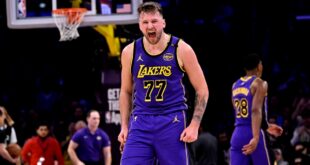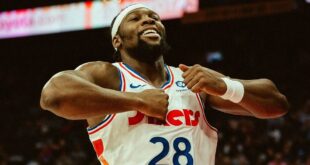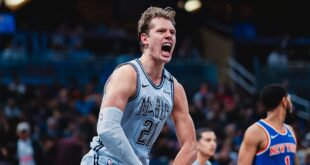LOS ANGELES — Pulling off a midseason trade that turned heads across the league and led to a significant transformation for two franchises? That was the easy part.
The real challenge for the Lakers now lies in establishing themselves as a title contender alongside Luka Dončić — and possibly also with LeBron James, whose career clock is ticking as midnight approaches.
In an era constrained by salary cap limitations, this task is particularly daunting for a franchise historically accustomed to hoisting the trophy. The Lakers have always managed to secure at least one championship in every decade, apart from the 1960s (when they relocated to Los Angeles) and the 1990s (despite reaching the NBA Finals in 1991).
Speaking of trades: the acquisition of Dončić has altered the landscape for the Lakers as James approaches the twilight of his career, which feels like it could last indefinitely but will eventually come to an end. The Lakers now benefit from having a 26-year-old generational talent while simultaneously managing the impending retirement of a player who will turn 41 this December.
During their inaugural season together, Dončić and James raised the expectations and, somewhat unexpectedly, quickly met them by securing the No. 3 seed in the Western Conference only to succumb to the Minnesota Timberwolves in the first round of the playoffs, losing in five games.
Despite the disappointing conclusion, that was merely a preview of what’s to come.
Now, the time has come for the devoted Lakers fanbase to start demanding the main course… followed by second and third servings.
What’s next for the Lakers?
First and foremost, the focus shouldn’t be solely on James or Dončić. It revolves around Austin Reaves.
Any substantial changes to the roster hinge on Reaves, who stands out as their most valuable trade asset and perhaps the team’s only real bargaining chip, apart from the two stars who aren’t going anywhere.
They can’t make significant acquisitions unless they part ways with the creative 26-year-old guard, who has one of the most team-friendly contracts in the league at $14 million for the upcoming season, along with a $15 million option for the following year (which he’ll certainly decline in search of a lucrative extension).
Reaves has emerged as a promising NBA talent, evolving from an undrafted player to a reliable starter. His proficiency in creating his own shots, ability to shoot from beyond the arc, and knack for drawing fouls with a quick pump fake have significantly increased his value across the league.
In what should have been a win-or-go-home scenario, the Lakers appeared “disinterested” during the game, particularly on the defensive side.
Surprisingly, the Lakers have managed to retain Reaves over the past few seasons (and notably excluded him from the Dončić trade negotiations with Dallas). This became a point of contention for Mavericks supporters and league insiders, who questioned how Mavs GM Nico Harrison, exclusively negotiating with the Lakers, failed to land Reaves and thus address the backcourt gap left by Dončić’s exit.
Cheers to Rob Pelinka for that. However, now the Lakers’ GM, who just secured a contract renewal, must think outside the box if he wishes to keep Reaves and attract significant talent.
So, here are some potential pathways for the Lakers:
• **Trade Reaves.** This is their primary route to acquire quality size, which is the Lakers’ most urgent need. Additionally, the team already possesses two players who can replicate what Reaves offers — Dončić and James, both of whom are also creative, albeit at a higher level.
Lakers coach JJ Redick effectively operated without a center during the Timberwolves playoff series, even opting not to start one in Game 5. Currently, there’s no more viable option on the roster than Jaxson Hayes.
The center position could have been solidified had the Lakers decided to keep Mark Williams, an athletic 7-footer with considerable potential, in a midseason trade with the Hornets. However, reports suggested that Williams failed his physical, prompting Pelinka to backtrack on the deal.
This setback sent the Lakers back to square one in their quest for a rebounder and rim protector to replace Anthony Davis, who was sacrificed in the Dončić trade. Securing a top-tier center would likely require moving on from Reaves — assuming any are available on the market.
In case the Lakers consider less costly options, centers like Toronto Raptors’ Jakob Poeltl, Utah Jazz’s Walker Kessler, Chicago Bulls’ Nikola Vučević, and Brooklyn Nets’ Nic Claxton may be on the trading block.
If Reaves remains with the team, the Lakers might look for centers who have a short shelf life, such as veterans Brook Lopez and Clint Capela, both unrestricted free agents this offseason.
To summarize, this team is in dire need of a big man, and based on Redick’s playoff rotations, there’s currently no one they trust among their roster.
The Lakers’ size deficiency was glaring in Game 5, where Rudy Gobert dominated, facilitating the Wolves’ victory over L.A.
• **Prioritize player development.** The Lakers were praised when Dalton Knecht unexpectedly fell to them in the previous June’s draft and began his rookie season impressively, eventually earning a spot in the starting lineup.
However, he then fell out of favor, primarily due to defensive shortcomings. The Lakers even included him initially in the Williams trade back in February.
They could focus on his development this summer and hope to see an improved player return next season. If he progresses, they could either retain him for his shooting ability or consider trading him during the deadline if an unexpected player becomes available.
Do the Lakers believe Rui Hachimura has maximized his potential? The same question applies to Dorian Finney-Smith, Gabe Vincent, and others. If the Lakers commit to this supporting cast next season and none of them elevate their game, they risk replicating their previous results — a team that wins 45-50 games but lacks playoff depth.
• **Keep an eye out for a “discontented star.”** This scenario arises nearly every season when a star player seeks a trade and tries to direct their destination. The most recent instance was De’Aaron Fox, who orchestrated a move from Sacramento to San Antonio, his desired location.
The Lakers remain an attractive destination, especially with Dončić in the mix.
Throughout history, iconic players like Wilt Chamberlain, Kareem Abdul-Jabbar, Shaquille O’Neal, and more have desired to wear the Lakers’ colors.
The opportunity to capitalize on James’ remaining years and play alongside Dončić — both of whom excel at passing — could entice a star player seeking a change.
• **Avoid rushing to win with James.** If the Lakers prioritize Dončić as their focus for the future above all else, they may choose to disregard any pressure to expedite the process for James’ last couple of seasons. This means retaining and extending Reaves while gradually adding components over the coming years, regardless of James’ status.
This lays out the landscape as the Lakers brace for an eventful offseason in their pursuit of creating a championship-caliber team.
It’s a welcome challenge to tackle. In these financially restricted times, acquiring and maintaining two superstars — let alone three — is a significant undertaking. A team that has two stars is immediately viewed as a title contender, provided the rest of the roster performs effectively, even if there isn’t a third potential All-Star.
When the Lakers orchestrated the trade for Dončić, it was with an eye on the future, considering that Davis is 32. The time for planning for the future starts now.
* * *
Shaun Powell has been covering the NBA for over 25 years. You can reach him via email here, browse his archives here, and follow him on X.
The opinions expressed on this page do not necessarily reflect those of the NBA, its teams, or Warner Bros. Discovery.
 NBA News NBA News, Match Reports and Updates
NBA News NBA News, Match Reports and Updates



